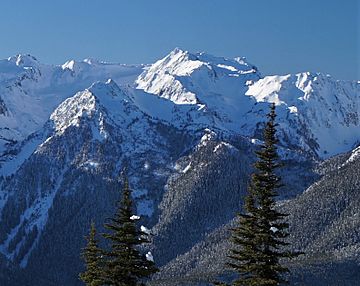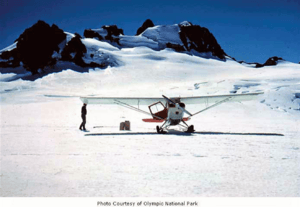Mount Fairchild facts for kids
Quick facts for kids Mount Fairchild |
|
|---|---|

Mount Fairchild from Hurricane Ridge
|
|
| Highest point | |
| Elevation | 6,900 ft (2,100 m) |
| Prominence | 450 ft (140 m) |
| Isolation | 0.85 mi (1.37 km) |
| Parent peak | Mount Carrie (6,995 ft) |
| Geography | |
| Location | Olympic National Park Clallam County, Washington, US |
| Parent range | Olympic Mountains |
| Topo map | USGS Mount Carrie |
| Geology | |
| Age of rock | Eocene |
| Climbing | |
| First ascent | 1963 |
| Easiest route | class 3 scrambling |
Mount Fairchild, also known as Mount William Fairchild, is a tall mountain in Olympic National Park in Washington state. It stands about 6,900-foot (2,100-metre) high and has glaciers on its slopes. This mountain is the second-highest peak in the Bailey Range, which is part of the larger Olympic Mountains.
Mount Fairchild is close to other peaks like Mount Carrie and Ruth Peak. If the weather is clear, you can even see it from the visitor center at Hurricane Ridge. Water from the mountain flows into streams that feed the Elwha River.
History of Mount Fairchild

Mount Fairchild, along with Fairchild Creek and Fairchild Glacier, is named after a pilot named William R. Fairchild (1926–1969). He was a very important pilot who flew many times over the Olympic Mountains. His flights helped scientists from the U.S. Geological Survey and U.S. National Park Service study glaciers. He also flew over thousands of other glaciers in Western North America.
Fairchild had a special way of taking off from the nearby Blue Glacier. This method became famous as the "Fairchild sleigh ride." It was even shown in an episode of the "Lassie" TV show!
Sadly, William R. Fairchild passed away in a plane accident on February 5, 1969. He was one of ten people who died when the air taxi service he started crashed after taking off from Port Angeles. The mountain was officially named in his honor in 1975. The William R. Fairchild International Airport in Port Angeles is also named after him.
The first time anyone successfully climbed this mountain was in 1963. The climbing team included Denny Pruitt, Dan Baker, Jack Christiansen, and Roy Etten.
Mountain Climate
Mount Fairchild is located in a "marine west coast" climate zone. This means it gets a lot of moisture from the Pacific Ocean. This climate helps support the glaciers on the mountain, like the Fairchild and Carrie Glaciers.
Most weather systems come from the Pacific Ocean and move towards the Olympic Mountains. When these weather systems hit the tall mountains, they are forced to rise. As they rise, they cool down and drop their moisture as rain or snow. This is why the Olympic Mountains get a lot of precipitation, especially in winter.
During the winter, the weather is usually cloudy. But in the summer, high-pressure systems over the Pacific Ocean often bring clear skies. The best months to visit or climb Mount Fairchild are usually from July to September.
Geology of the Olympics
The rocks that make up the Olympic Mountains were formed from material pushed up from the ocean floor. These rocks are mainly sandstone and basalt from a time called the Eocene era.
Over millions of years, especially during the Pleistocene Ice Age, glaciers played a huge role in shaping these mountains. They advanced and retreated many times, carving out the valleys and peaks we see today.



